Submissions of 303rd Bomb Group related stories and articles are most welcome.



January 27, 2013
Volume V, Issue 1
www.303rdBG.com
A loving tribute by his nephew Joel Wight
 |
Seventy years ago (January 23, 1943) American bomber B-17F Beats Me #41-24567 360th BS (PU-J) fell from the sky over Pluvigner, France. My Uncle Joe, the pilot, died with all but three of the crew members. These three managed to parachute safely and became prisoners of war. I was born 8 months almost to the day after Uncle Joe died. I never knew him and wish I had.
Sometimes we fail to remember that the life of each person lost in war in military service is a full story about a seemingly ordinary person who does an extraordinary thing-a life story of courage, commitment, hopes, dreams and, often, unfulfilled potential. It is also a family story of love and loss.
This is a brief and partial glimpse of just such a story about Joseph E. Haas-second child of Rena (Condit) and Ed Haas. Joe ("Buddie" or "Bud" as he was called in the family) had an older sister, Maxine (my mother), a younger brother, Larry, and a younger sister, Virginia ("Ginna"). Joe was born on August 3, 1919 in Rupert, Idaho, near where his parents owned a farm on the Snake River. Rena persuaded Ed to sell the farm on a handshake before the Great Depression so he could go to college in Iowa. When the Depression hit, the buyer of the farm defaulted and Ed and Rena lost the farm because they had no written contract showing their right to it. This deeply saddened Ed and Rena, impoverished the family and eventually probably contributed to their divorce. The family moved to the Bay Area in California near San Jose where Rena opened a beauty parlor to pay family expenses. As with many families at that time, though financially poor, they felt rich in their love for each other.
Pictures of Uncle Joe's childhood make me want to know how Joe perceived and experienced life in those years (one wants to know these things when it is not possible because Joe cannot tell you). He seemed to be a pretty normal kid surrounded by his extended family and school classmates. Family members remember Joe as much loved and a joy to them during this time and throughout his life.
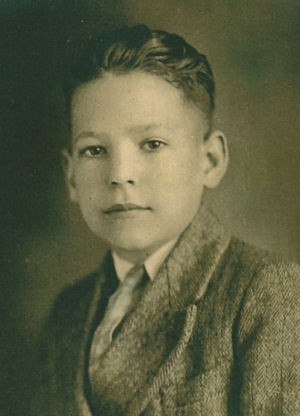

Pictures of Joe moving into adolescence show a handsome young man who his sister Maxine is beginning to appreciate for his intelligence and scholastic ability (she was equally blessed).
The smile on Joe's face as a youth portrays a young man who seems happy with the world and has a pleasant disposition. You can see his and his sister's love and respect for each other from the inscriptions on some of the pictures from that time. By the time Joe was attending San Jose State College, the seriousness and responsibility of life as an adult seems to have been becoming increasingly clear to him. This is the time when most of us are thinking about what to make of our lives, and Joe's was rich with possibilities. He moved out of his mother's home to stay with an older couple to help with his college and the family's expenses.
Joe distinguished himself as the business manager of the San Jose State college newspaper, the Spartan Daily, garnering enough ads in one quarter to meet the budget for the year. Joe moved on from San Jose State to Stanford, and received the founder's (Leland Stanford, Jr.) memorial scholarship.
When WWII came, Joe was already learning to fly and became the pilot of B-17F Hunga Dunga #41-24558 358th BS (VK-F) stationed in Molesworth, England, at the end of 1942. Joe and his crew flew the original missions of the Americans at Molesworth until his death during Mission No. 11 piloting Beats Me on January 23, 1943. Joe's B-17 Hunga Dunga was undergoing repairs from a previous mission, and Joe was substituting for the pilot of Beats Me, Mel Schulstad, who was sick with the flu. Mel died last year at the age of 94, and I had the privilege of meeting him just a year earlier.

Joe enjoyed flying. He trained in the Stearman PT-17, appreciated his Army instructor and classmates and enjoyed photographing the campus of Stanford University during one training flight.
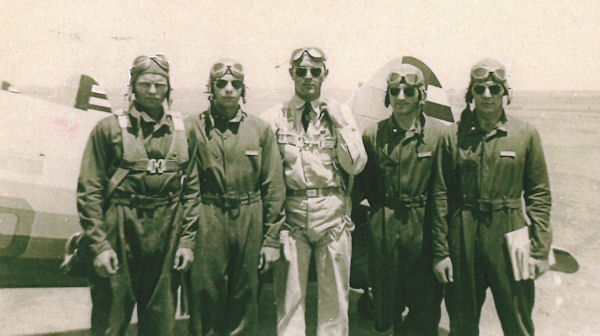
Joe, second from the left with his instructor, center, and classmates.
America's entry into WWII on December 7, 1941, changed everything for Joe and his family. Both Joe and his brother Larry served during WWII on bombers. Joe had enlisted in the Army Air Corps in September 1941 and became a B-17 pilot (later in the war Larry became a belly gunner and survived). The conflicting emotions of loving flying and loving and missing his family are apparent during this time. Joe loved his mother very much. After joining the service, he sent her a telegram in May of 1942 from Boise Idaho saying "All the love in the world to the best mother in the world. Joe."
 I don't have much information about Joe's service during most of 1942. Just that he "had been with the B-17s at Midway in June 1942." In the fall of 1942, he was sent with his crew to Molesworth, England (one of the original crews there) with their brand new B-17, the Hunga Dunga (I don't know why he and his crew selected that name-Beats Me was named because the only response to the question of what to name it was "beats me!"). His crew was part of the 358th Bomb Squadron of the 303rd Bomb Group known as the "Hell's Angels" stationed at Molesworth. They flew the first bombing missions of the war over France attacking German submarine pens and other military targets. These were dangerous missions to fly because we still didn't have needed fighter escorts for our bombers. The box formation was developed to help counter this problem. My mother said Joe was aware of the danger, and had a premonition that he wouldn't make it. Still, pictures of him at this time show the same engaging smile and personality that characterized him. I don't think Joe kept a diary during the war. What we know of his experience is based on others' first hand and news accounts.
I don't have much information about Joe's service during most of 1942. Just that he "had been with the B-17s at Midway in June 1942." In the fall of 1942, he was sent with his crew to Molesworth, England (one of the original crews there) with their brand new B-17, the Hunga Dunga (I don't know why he and his crew selected that name-Beats Me was named because the only response to the question of what to name it was "beats me!"). His crew was part of the 358th Bomb Squadron of the 303rd Bomb Group known as the "Hell's Angels" stationed at Molesworth. They flew the first bombing missions of the war over France attacking German submarine pens and other military targets. These were dangerous missions to fly because we still didn't have needed fighter escorts for our bombers. The box formation was developed to help counter this problem. My mother said Joe was aware of the danger, and had a premonition that he wouldn't make it. Still, pictures of him at this time show the same engaging smile and personality that characterized him. I don't think Joe kept a diary during the war. What we know of his experience is based on others' first hand and news accounts.
An account in the San Jose Mercury of Sunday, January 10, 1943, mentions his skill "in flying back to its base a Boeing fortress which literally had been shot full of holes…." The Minidoka County News (an Idaho paper covering Rupert, Idaho) on April 23, 1943, posthumously described Joe's feat gleaned from "dispatches coming from London 'During a combat raid early in January Lieut. Haas miraculously brough[t] his Flying Fortress back to its base after it had been severely damaged; one wing torn, tail assembly shattered beyond use, elevator stabilizer completely smashed; a huge hole in one of the propeller blades, oxygen tanks, radio hatch and anti-ice tank destroyed, and wings and fuselage torn to shreds by bullet and canon fire.' For this daring feat he was to have been promoted to the rank of captain, but another raid January 23 cost his life."
Though I'm not certain, I believe this may have occurred during Mission No. 7 to attack the air depot at Romilly-Sur-Seine, France on December 20, 1942 (I have seen pictures of Joe and the Hunga Dunga shot full of holes, but have been unable to find them). After this Mission, Hunga Dunga did not participate in its next mission until January 13, 1943 (Mission No. 10).
A review of the early missions flown by the 303rd BG shows that crews and planes were frequently interchanged because of the toll of war. Hunga Dunga did not fly Mission No. 11, so Joe was the substitute pilot for Mel Schulstad, suffering from the flu, on Beats Me, Mel's plane. As was often the case in the missions Joe flew, his plane was "Tail End Charlie" in the box formation on Mission No. 11. There are some inherent dangers for planes in this position as the last to pass over the target.
In the early afternoon of January 23, 1943, as Joe's formation of 303rd BG aircraft was engaged over the target of the submarine pens at Lorient, France, another formation of B-17s above the 303rd BG released its bombs. These fell through the 303rd formation. Charles (Chuck) Roth the radio operator on Beats Me remembers looking up and seeing the planes above with open bombay doors. As Chuck recounts, one of these bombs hit Beats Me severing the vertical stabilizer, killing the tail gunner, Wayne Stevens, and flipping Beats Me upside down. Joe was able to right the plane, but it had fallen out of formation on impact. As Beats Me fell away with Joe fighting for control, two German FW-190 fighter planes closed in. Chuck remembers manning one of the waist guns for fallen gunner John Sherman and a raging gun battle that lasted what seemed like 10 minutes with one of the German fighters shot down. Suddenly, Beats Me nosed over and began spiraling toward the ground. Chuck believes Joe and the co-pilot, Roy Christensen may have been hit by fire or shrapnel from the FW-190 attack. Chuck was the last man out of Beats Me before it crashed. He was literally knocked from the plane while trying to get out-perhaps by a rear door which separated from the plane and fell to the ground just before the crash.
One French account by Maurice Deimat in 1992 recalling the view of the drama from the ground says "the pilot, without doubt, had the reflex to avoid a populated area." Pierre Le Neillon, the first on the scene of the crash, wrote in his account:
"I realized that the plane was about to crash, although the B-17 went on flying straight ahead. She actually lost speed until she reared backwards and turned on her left wing, then finally dived toward the ground. Her engines made a terrible noise. For a few minutes, as I saw her getting bigger and bigger, I thought she was going to fall on my head! Eventually she crashed at 500m from where I was-in a terrific explosion. A huge black cloud rose high in the sky, whereas the earth was shaking under my feet. I was astounded and scared; nevertheless, I decided to run toward the spot. People came from all around."
Pierre's son, Hubert, is writing a book about Beats Me.
Chuck Roth's account of the crash, understandably, is focused on the life and death struggle within his plane, the running battle with the FW-190s, getting himself out of the plane and watching the unfolding crash from his parachute. He said "I watched Beats Me go straight down." Once on the ground, Chuck was attended to by Frenchmen at the scene who cared for him until the Germans took him prisoner (Chuck was aware of several members of the French Resistance being executed by the Germans shortly after he was imprisoned, and worried that he might be next). The small village of Pluvigner responded bravely at the time of the crash and continues to commemorate the crew of Beats Me.
The other eye-witness account of a surviving crew member of Beats Me is that of Ewell McCright, the bombardier on the flight. Like Joe, Ewell had come from another group, the 427th BG, to substitute on this mission. Ewell was one of the three who successfully parachuted from the plane and was captured. His account is contained in a letter dated November 6, 1946, to the mother of John Sherman (the waist gunner whose gun Chuck Roth commanded after John was killed). Ewell's memory of the gun battle is dominated by the running fight with FW-190s. He recounts the evasive maneuvers taken by Joe to avoid these fighters, and how this drove Beats Me further and further from the B-17 formation. Ewell writes that Joe "maneuvered the ship excellently," but it seemed the plane was hit repeatedly in the attacks (Ewell says there were 285 eighty-one millimeter flak guns shooting from the ground and 40 to 100 FW 190s in the air-Beats Me had no fighter escort; it was still too early in the war).
Finally, one of the fighter attacks "blew a hole about three feet in diameter in the left side of the nose part of the fuselage." This must have killed Joe as it was on the pilot's side of the plane. The plane went into a spiral, and this is when the three crewmen who lived, John Embach the navigator, Ewell and Chuck, with considerable difficulty bailed out. The co-pilot, Roy Christianson, also got out of the plane, but Ewell believes his chute had been riddled by gunfire and split on opening. This is consistent with eyewitness accounts from the ground-Roy's was the only body recovered. The remains of the rest of the crew, including Joe, were eventually returned to America in 1951 and are interred in a common grave in the Rock Island National Cemetery (on an island in the middle of the Mississippi River) at Rock Island, Illinois.
On February 6, 1943, Joe's dad, Ed, wrote to Rena; "My dear wife-Mrs. Schatz [the wife of the couple with whom Joe had lived while at Stanford] just phoned me that she rec'd a telegram from the war dep't. that Joe was missing in action on January 23….Let us hope that he is still alive. It might be better if he is a prisoner of war than to keep flying, as the average flyer is downed in one out of twenty trips. … Tel-reads that they would send another tel-when they rec'd further word. It's pretty hard to take, but I have had my mind in a receptive condition for a long time for just such news, knowing that flyers have so little chance."

The January 28, 1943 article (probably from the San Jose newspaper) tells of Joe's death. The picture shows him waving from the cockpit of his plane, the Hunga Dunga some time prior to his final flight on Beats Me (Joe's nickname "Little Joe" is right below his window).
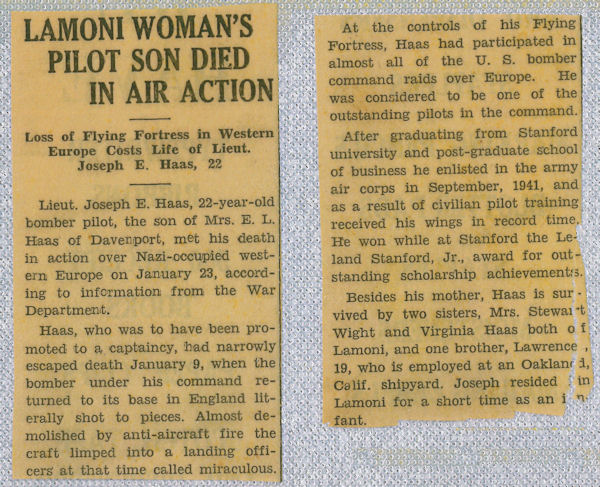
The loss of a loved one in war (or for any reason) leaves a void which can never be filled. But that does not detract from our memories of the powerful force of that loved one while present among us. These memories sustain us and must be preserved.
A letter to Joe's mom, Rena, following Joe's death dated May 15, 1943 from his older cousin Verda, provided these words of comfort: "Aunt Pearl (Rena's sister) wrote us the sad news of Buddy. I know that it is a great blow to all of you. But Aunt Rena, you have something to be thankful for that many a Mother will not. Joseph Haas was one of the most perfect boys who ever lived. He was a darling when he was small and a perfect man as he grew older. I can't even think of a fault that he had. The few minutes that we saw him when he was here, we shall treasure all our lives. He was so handsome and seemed very happy."
London Daily Telegram - 5 Feb 2012
Gwen, a longtime friend of the 303rd Bomb Group, originally provided her story in an exclusive to the 303rd BGA's Hell's Angel's Newsletter, published in the May 2000 issue. When the London Daily Telegram honored her last year, she provided a copy of the article to former HANL Editor Eddie Deerfield. Thanks to Gwen, Eddie and the London Daily Telegram for this reprise.
 During World War II, Rainbow Corner, the American Red Cross Club near Piccadilly Circus in London, was the most famous in the ETO. For 24 hours a day, every day, it was open to American servicemen from 11 November 1942 to 9 January 1946. In addition to extensive recreation facilities and programs, the club offered excellent food service.
During World War II, Rainbow Corner, the American Red Cross Club near Piccadilly Circus in London, was the most famous in the ETO. For 24 hours a day, every day, it was open to American servicemen from 11 November 1942 to 9 January 1946. In addition to extensive recreation facilities and programs, the club offered excellent food service.
Born on 19 September 1926, Gwendoline lives in London. She received a letter from Eleanor Roosevelt, thanking her for jitterbugging and jiving with GIs.
I grew up in north London, so when the war was declared you could say that we were in the thick of it. I remember so many nights, cold and damp, huddled in our Anderson air-raid shelter listening to the shrapnel hitting the houses and hoping it wouldn't be a bomb next.
I left school just before my 14th birthday and got a job as a junior clerk in an office. Later to improve my skills I learnt typing at evening classes, and that meant I could move on to offices in central London. One day I was travelling home on the Tube and I got chatting to a woman who worked for the American Red Cross. I told her I loved to dance and she asked me if I'd like to be a voluntary hostess at Rainbow Corner on Shaftesbury Avenue.
 It was a famous club, open 24 hours to American servicemen, and it was a place where they could get everything from a shave, haircut and meal to a glass of cold Coke and a jive. One of the favourite areas was called Dunker's Den, in the basement They gave you doughnuts and coffee, and there was always music playing on the juke-box.
It was a famous club, open 24 hours to American servicemen, and it was a place where they could get everything from a shave, haircut and meal to a glass of cold Coke and a jive. One of the favourite areas was called Dunker's Den, in the basement They gave you doughnuts and coffee, and there was always music playing on the juke-box.
I worked the evening slots, which meant I'd be at my office all day, then arrive at the club at 7pm and stay until 10:30pm. In those days I had loads of energy. Primarily it was my job to dance with the GIs. On my first evening in the ballroom one GI asked me to jitterbug - and, of course, I didn't have a clue. Luckily I was quick at picking up the steps and made a pretty decent job of it.
In general the GIs had a terrible reputation, but I thought they were wonderful. Often I felt sorry for them, because they were a long way from home and many never went back. You'd get to know them and then the next minute hear they'd gone on a raid and were dead. It always shocked me.
Obviously, romances happened. I became friendly with one man, Steven Baker. He was a medic in the 8th Air Force but he was also the trombone player in the band. We went out a few times and I'm still in correspondence with him to this day. He lives in Indiana, a lovely fellow.
I met some incredible people. Fred Astaire's sister, Adele, worked in the club, helping the boys write letters home, and loads of famous people passed through - James Stewart, Eisenhower, Irving Berlin. I saw Glenn Miller perform with his band, and Petula Clark, when she was a really young girl, regularly sang for us.
Life seemed pretty dull after the club closed at the end of the war. Everyone who'd worked there got a personal thank you letter from Eleanor Roosevelt. I carried on with office work, and married in 1957, then my only son came later. I had an interest in seeing the world, so travelling was a pleasure for me. I went on the QEII in 1959 to New York. That was exciting, but since my husband died in 2003 I haven't been far.
These days I try to keep active. I regularly do my leg exercises, and sometimes I go to the theatre. But there's one thing I'd never do now. During the war I'd walk home alone in total darkness in the blackout and I'd never feel afraid. Sadly, you can't do that today for fear of being attacked.
I have seen the Queen close up a couple of times. My husband managed a shop in Haymarket during the 195os and on her Coronation we were inside, celebrating with a few drinks, when we saw her go past in the royal car. She looked lovely. Then in the 1990s she opened a centre near to where I live, so I went along. She's fantastic for her age: she always looks well put together and she's got incredible skin. I quite fancy seeing the Royal Barge during the Jubilee celebrations, but I'm not sure I could manage the crowds now. I wonder, if she reads this, will I get an invite to Buckingham Palace?
![]()
by Peter G. Park, RAF Molesworth Historian
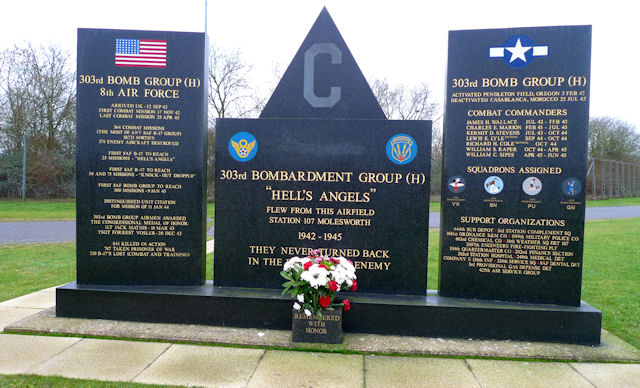
As historian here at Molesworth I am privileged to drive by the beautiful granite 303rd Bomb Group (Heavy) Memorial at least twice a day. I almost always look at it, if only for a moment and think of the brave men who served here. It is especially beautiful in the darkness of the morning bathed in the lights that shine on it 24 hours a day. That Tuesday, a week before Christmas, I noticed a beautiful bouquet of fresh flowers in the urn in front of the memorial. Curious as to by whom?, and why?, fresh flowers had been placed, I turned my car around.
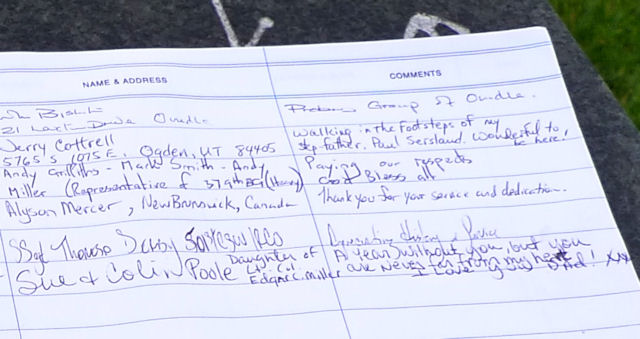
As I parked near the memorial it slowly dawned on me the significance of the date. I had a pretty good feeling who had placed the flowers. Sure enough, there in the visitors book was the inscription "Sue Poole, daughter of Lt Col Edgar Miller." In the Comments box she wrote: " A year without you, but you are never far from my heart - I love you Dad."
This wasn't the first time Ms. Poole who lives with her British husband Colin about 15 miles from Molesworth had graced us with flowers. The flowers began exactly a year earlier. Sadly, on 16 December 2011 Sue Poole learned of the death of her father Lt Col Edgar Miller, USAF (Retired). Despite her overwhelming grief, Sue knew immediately and instinctively that she had to visit Molesworth where the memorial symbolizes her connection with her father and his service along with the 8,959 other members of the 303rd who served here. The first of Sue's notes in the visitor's book on 17 December 2011 read "I love you Dad. I'll never forget you xxx."
Sue had first visited here three years earlier in February 2008 when she officiated as several binders which her father had painstakingly assembled with information on each of the members of the 303rd, were officially donated to RAF Molesworth (see Molesworth Pilot article at http://www.303rdbg.com/miller-rosters.html )
On 2 March 2012 the flag which had accompanied Lt. Col Miller during his funeral in the States was flown over Molesworth by the RAF Molesworth honor guard with Sue Poole and her husband Colin in attendance. In the visitor's book she wrote: "They are flying the flag in your honor today, Dad. I love you, it is a glorious day." The event was reported in the Molesworth Pilot at http://www.303rdbg.com/news/2012-03-18.html
And five months later on 19 August 2012 more beautiful flowers appeared as if by magic. "Lovely day today - I just thought the memorial needed some flowers and a quiet remembrance for me" read the note in the visitor's book from Ms. Poole.
Thank you, Sue from all of us here at your father's base who see your lovely flowers!
![]()

Leo Lanier, Jr. turned 90 on January 14, 2013. Leo was a gunner on the 360th BS Bill Heller Crew. As Bill passed away just over a year ago, Leo is now the sole survivor of the crew. Leo and his wife Reita live in Summerville, Georgia and are doing well.
This photo, taken in about 2000, was sent by Dr. Ron Sale of Bedfordshire, England. Ron and his wife Lesley are pictured above with Reita and Leo.
Ron wrote, "My wife and I first met Leo Lanier, Jr and his dear wife while on holiday in Savannah, several years ago. Though we are of different ages and live thousands of miles distant from each other we have remained friends ever since. Leo heard my accent and enquired if I was British, which I am.
Further to my response he told me of his times spent at Molesworth (not too far from where I now live). To cut a long story short, I encouraged Leo to let me collect him from Heathrow airport during his visit to England the following year so I could take him back, for the first time since the end of WW2, to Molesworth. Much to Leo's surprise, I had arranged with the base to receive Leo as a Veteran, and he had an official salute along with much thanks and courtesy shown by the Base Commander. Leo thought that all he was going to see was an empty airfield! You can imagine the emotions the guy went through after all those years. It made his day and made his entire trip so worthwhile. He has momentoes from that day, and is one he'll always remember.
"As a Veteran of the 303rd Bomb Group (Heavy) and the 486th Bomb Group he relives, in his mind, his WW2 experiences on a daily basis. I know this because he once told me 'Ron, there's not a day that doesn't pass that I don't think of my times at Molesworth. Such was the impact of those times."
published in the Henrico Citizen - December 19, 2012
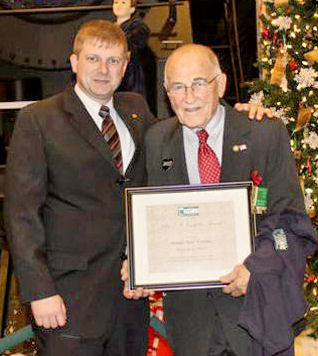 |
This is the third time Campen has been honored with the E.C. Compton Award, having won the award previously in 1991 and 2002. Campen was also recently recognized by the U.S. Dept. of Agriculture’s Natural Resources Conservation Service for 23 years of volunteer service with its “Earth Team”
published in the Branson Tri-Lakes News - July 27, 2012
By Sara Karnes
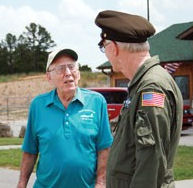 |
Known as the Texas Raiders, the authentically restored bomber is owned and flown by the Commemorative Air Force. Operation of the aircraft is assigned to the Gulf Coast Wing, an all-volunteer Commemorative Air Force membership group. To help support the flying operations of Texas Raiders, volunteers brought the bomber to Branson Airport this week, offering rides and tours through July 26.
Among the first to board the fully-restored bomber after it arrived in the Tri-Lakes Area earlier this week was Marvin Edwards.
Edwards, 89, flew with the 303rd Bomb Group (H) B-17 Bombers in 1943-44 during World War II with the Hell’s Angels. However, this was not the beginning of his military career.
In 1939, he served on the horse calvary and “carried a saber.” Once the Air Force program started, Edwards joined as a tail gunner.
“I ended up being a tail gunner because I was the last one there. I was the last naturally to be chosen for the position,” Edwards said.
Originally, Edwards was tasked to complete 30 missions, but he chose to remain with the Air Force to finish 51 additional missions.
Edwards was part of “the first planes over Berlin” and performed one of the first reconnaissance missions over the battle area of Normandy, he said.
Edwards learned the B-17 Bomber was going to fly into Branson from his daughter, Jane Dooley.
“I asked him if he wanted to go and he said, ‘I just want to hear those engines one more time,’” Dooley said.
Upon hearing that Edwards used to fly in B-17 Bombers, the Commemorative Air Force crew members asked him if he would like to go up with them.
Edwards was able to take to the air once more.
“There’s no other sound like these engines,” Edwards said. “No other roar.”
After taking off from the runway, the plane flew above the Branson area.
 |
In 1949, he started a National Guard unit in Pittsburg, Kansas. He became a unit commander for the Kansas National Guard, HQ 195th Field Artillery BN.
During the Korean conflict (1951-1952), Mr. Edwards served as a 1st Lt. in the 24th Division US Army (in Korea and Japan).
He returned to the United States and served in the National Guard until he received an honorable discharge on December 9, 1963. When he was discharged, Mr. Edwards was a Captain.
For many years, Mr. Edwards carried the flag in Branson's Veterans Day Parade. He also served in the Honor Guard at the burial of many veterans. Mr. Edwards is 88 and just gave up both of these activities a couple of years ago.
He is a member of both the American Legion and the VFW. His most recent honor was a trip on the Honor Flight to Washington, DC in June 2010.
![]()
|
— Historic Issues Revisited — This Month: October 1980 |
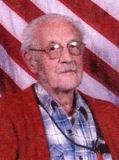 Lester Jacob Voth died on January 10, 2013 just one day short of his 94th birthday. He was born on January 11, 1919, in the Salt Creek area five miles north of Dallas, the son of Jacob and Mabel (Aebi) Voth. His grandparents, Henry and Aganetha Voth, had settled in the Salt Creek area around 1900. Lester Voth lived most of his life in Dallas. He started school at the one-room Orchards Grade School with teacher Miss Lena May, and graduated from Dallas High School in 1937. He worked at various farm jobs, including hauling hay, working in the prune dryer, until World War II began. Lester was very proud of his military service. He enlisted on October 20, 1941. He was discharged as a sergeant in the Army Air Force, on September 13, 1945, after serving in several locations abroad, including Casablanca, Morocco, and a final assignment at Molesworth Airfield, north of London, England. He was a mechanic, working on the B-17 and C-54 bombers that flew over Europe. He received a Good Conduct Medal, European Africa Middle Eastern Service Medal, American Defense Service Medal, and Distinguished Unit Badge GO 50 WD 44.
Lester Jacob Voth died on January 10, 2013 just one day short of his 94th birthday. He was born on January 11, 1919, in the Salt Creek area five miles north of Dallas, the son of Jacob and Mabel (Aebi) Voth. His grandparents, Henry and Aganetha Voth, had settled in the Salt Creek area around 1900. Lester Voth lived most of his life in Dallas. He started school at the one-room Orchards Grade School with teacher Miss Lena May, and graduated from Dallas High School in 1937. He worked at various farm jobs, including hauling hay, working in the prune dryer, until World War II began. Lester was very proud of his military service. He enlisted on October 20, 1941. He was discharged as a sergeant in the Army Air Force, on September 13, 1945, after serving in several locations abroad, including Casablanca, Morocco, and a final assignment at Molesworth Airfield, north of London, England. He was a mechanic, working on the B-17 and C-54 bombers that flew over Europe. He received a Good Conduct Medal, European Africa Middle Eastern Service Medal, American Defense Service Medal, and Distinguished Unit Badge GO 50 WD 44.
On returning home, Lester began seriously courting Grace Beltz, of Portland, Oregon, with whom he had maintained a correspondence during the war. They were married on November 2, 1945. Lester and Grace lived in Dallas following their marriage. He continued to work at various farm jobs; she worked at the Itemizer-Observer. In 1948, Lester found work with Alaska Airlines, and they moved to Everett, Washington. Both of their daughters were born in Everett: Leslie, in 1948, and Susan, in 1952. The family returned to Oregon in 1957, where Lester joined his father in the insurance business. They settled into the farmhouse built by Lester’s parents, next to Orchards School. In 1960, the family moved into Dallas, to a house built by Lester’s uncle Ben Lange (married to Mabel’s sister, Ella). Lester continued to work as an agent for Farmers’ Insurance for over 20 years, first in an office on Mill Street (present location of Bank of America) and later in his own building at Main and Walnut.
Lester loved flying and for years maintained a Cessna 182 at Joe Card’s airfield. In 1980, he suffered serious injuries when the engine of his small airplane failed at 8,200 feet, over rugged country east of Roseburg. His experience and skill as a pilot enabled him to bring the airplane to the ground in a controlled manner. Though he was injured, one passenger suffered only a broken ankle and the other, cousin Loren Lange, walked away from the crash for help. Lester retired shortly after the crash. He and Grace enjoyed traveling in trailers and RV’s, and spent most winters in the Palm Springs area. Grace died in May, 1990.
Lester married Muriel (Doughty) McCay in September, 1990. Both enjoyed traveling in their RV, especially to the coast, and in the winter, to Palm Springs and Desert Hot Springs. Muriel died in July, 2012. Lester was active in the Salt Creek Baptist Church throughout his life. He served as Deacon and Trustee, sang in the choir, and was involved with other committees and duties in support of church activities.
Lester is survived by a sister, Mildred Schneider, Portland; two daughters, Leslie Hauer (John), Richland, Washington, and Susan Scherrer (Dave), Westminster, Colorado; four grandchildren, Kristin Scherrer, Heather Jaeger, Diana Hauer, and Matthew Hauer, and one great granddaughter, Adria Holst.
A memorial service to celebrate his life and faith will be held at Salt Creek Baptist Church on February 9th at 11:00AM, followed by a time a fellowship, to which the family invites all to join them. Dallas Mortuary Tribute Center is caring for the family.
 James "Jim" Joseph Crooke, Jr., 91, passed away at his boyhood family home on Monday, January 7, 2013 at 11:05am.
James "Jim" Joseph Crooke, Jr., 91, passed away at his boyhood family home on Monday, January 7, 2013 at 11:05am.
Jim was born on April 11, 1921 in Pensacola, FL to the late James Joseph Crooke, Sr. and Claude Tresa Milstead Crooke. He had an older sister, the late Norine Crooke Coleman and many extended family members of the Crooke and Milstead name.
After graduating from Pensacola High School in 1939, he began his College career at the University of Florida in Gainesville. His education there was interrupted by the invasion of Pearl Harbor in 1941 and his enlistment in the Army Air Corp (now the US Air Force) where he was a Second Lt. Navigator on his beloved B17 bomber. Shot down near Berlin, Germany on his third mission on September 12, 1944, he became a Prisoner of War at Stalag Luft 1 in Barth, Germany where he remained until the war ended in 1945. He mourned until his death the loss of many of his crew.
Jim returned to the University of Florida after the War, enrolled in the School of Architecture and graduated in May, 1950. He practiced Architecture in Pensacola and the Florida Panhandle area until he retired in the mid 1990's. His primary work was helping churches plan and build new or renovate existing structures to provide space for the growth in membership as a Thankful Nation began to rebuild.
His love of God, love for his family, his beautiful voice and gift of many talents were all used his entire life in serving others. A faithful Christian, loving husband and father and a true Southern Gentleman is how we will treasure his memory.
He leaves behind on earth, Theresa, his wife of 65 years; his children, daughter, Carol Ann Lord and husband Larry, son, James J. Crooke III and wife Deborah and daughter, Deena Crooke; grandchildren, Lucas and Wesley Lord, Lindy Kay Lord Hayes and husband Andy (serving US Army), Angela Crooke, Jeanie Peaden, William David Crooke (serving US Army) and James Joseph Crooke IV (serving US Navy); great grandchildren; Elaina Kay, Angel and Kevin Hayes and Caiden Lord; nephew, Randy Coleman and wife Lynn; nieces, Jane and Emmie Coleman and their extended families along with his many cherished friends.
Visitation will be held from 1:00pm Wednesday, January 9, 2013 until services beginning at 2:00pm at Harper-Morris Memorial Chapel, with Dr. Karen Evans and Rev. Herstel Carter officiating.
Interment will be held at Barrancas National Cemetery on Thursday, January 10, 2013 at 10:15am.
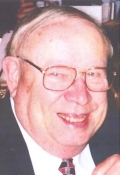 Gerhard W. "Bill" Loessin, 88, of Middletown, DE passed away on Saturday, December 22, 2012 at the Christiana Hospital in Newark.
Gerhard W. "Bill" Loessin, 88, of Middletown, DE passed away on Saturday, December 22, 2012 at the Christiana Hospital in Newark.
Born in Philadelphia, PA he was the son of the late Gerhard W. Loessin, Sr. and Clara Kobold Loessin. Bill was veteran of the U.S. Army Air Corp during WWII serving as a Ball Turret taking part in 35 missions over Germany, France and Belgium. He was a member of the 303rd Bomb Group. Following his return home he began his career as a plumber and was a member of the Plumber and Pipe fitters Local 74 since 1951.
Bill is survived by his son, Robert "Will" Loessin; daughter, Carol Loessin and many nieces and nephews. He was predeceased by his wife Kay in 2011 and 4 sisters.
Funeral Services will be held on Monday, December 31, at 2 pm in the Chapel at Delaware Veterans Memorial Cemetery, Bear, DE. Family and friends may visit on Wednesday, December 31 from 12:30 to 1:15 pm at the Doherty Funeral Home, 3200 Limestone Rd., Pike Creek.
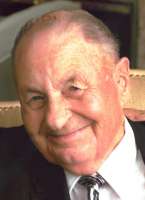 Elmer L. "Pete" Peterson, 92, of Beaverton, Ore., died of natural causes Wednesday, Dec. 19, in an Oregon hospital.
Elmer L. "Pete" Peterson, 92, of Beaverton, Ore., died of natural causes Wednesday, Dec. 19, in an Oregon hospital.
His celebration of life is 11 a.m. Saturday at Young's Funeral Home in Tigard, Ore. A private ceremony will be held with full military honors in Willamette National Cemetery, Ore. Young's Funeral Home handled arrangements.
Pete was born in Butte, graduating from Butte High School in 1939. He attended business college in Butte and began working for Personal Finance and Credit Company and ultimately managed it before joining the service in 1942. Pete was a veteran of the Army Air Force during World War II, serving briefly with the 92nd Bomb Group in Alconbury, England. He transferred to the famed "Hell's Angels" 303rd Bomb Group, 360th Bomb Squadron, where he flew 28 missions in B-17G's out of Molesworth, England. His service spanned from September 1942 to October 1945. He was a waist gunner, bombardier and a bomb sight instructor after he served his combat duty. For his service, Pete was awarded the E.M.A.E Theatre ribbon w/2 bronze stars, 1 Overseas Service Bar, 1 Service Stripe, the Air Medal w/3 bronze oak clusters and the Distinguished Flying Cross.
Stateside in 1944, he married Mae Rose Hubert, whom he had known at Butte High. They had three daughters, Kathe, Susan and Diane all born in Montana. Pete partnered in a doughnut shop and restaurant in Missoula before moving to Great Falls to work at Oil Exploratory Systems. In 1965, he went to work for the U.S. Treasury Department and eventually transferred to Portland in 1972. He excelled in his career expanding U.S. Savings Bonds in Oregon, receiving many awards and retired in 1983. Pete and Mae enjoyed 63 years of marriage, returning to Butte for many high school reunions before Mae's passing in 2008.Pete is survived by two daughters, Susan Bond and her husband, Dan of Tigard and their children, Jennifer and Rachel; and Diane Carter and her husband, Chris of West Linn, Ore., and their children, Logan and Braeden.
He was preceded in death by his daughter, Kathe in 2011.
Pete will be remembered for his enthusiasm for life, being lighthearted, always with a smile on his face and kind words of appreciation. All who knew him will remember a joke he shared that kept them laughing. He had a sharp mind and was always ready with a story to tell. Pete was dearly loved and will be greatly missed by his family and all who knew him.
Contributions in his memory may be made to the American Legion, Vietnam Veterans of America or the veterans organization of your choice.
Condolences may be posted online at www.gftribune.com/obituaries.
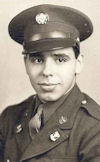
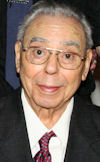 Floyd Sylvestor Sanelli passed away early Friday morning on June 15, 2012, in the comfort of his home in Bellevue, having lived a full life of 90 years. Floyd was born on April 27, 1922, in cabin #27 of the Bicelighla Cannery on Monterey Hwy., in San Jose, California. His birth name was Fiorino, but in 1st grade his teacher, Ms. Campezi, told him his name was Floyd from now on…so that's what everyone called him!
Floyd Sylvestor Sanelli passed away early Friday morning on June 15, 2012, in the comfort of his home in Bellevue, having lived a full life of 90 years. Floyd was born on April 27, 1922, in cabin #27 of the Bicelighla Cannery on Monterey Hwy., in San Jose, California. His birth name was Fiorino, but in 1st grade his teacher, Ms. Campezi, told him his name was Floyd from now on…so that's what everyone called him!
He went on to graduate from a technical high school and worked a few jobs at a couple of newspapers. Floyd ended up working at a printing company named Muirson Label Company.
At the age of 20 he enlisted in WWII. He flew 52 missions as an Engineer and Top Turret Gunner with his group of fellow soldiers known as ''The Hells Angels'', on a B-17 Bomber named the ''The Bonnie B''. He was stationed in Molesworth England from 1942-1945. After he returned from the war, he decided to legally changed his name to Floyd.
He went back to work for Muirson Label after the war, and then received a job from another printing company called Container Corporation of America (CCA). At the age of 27 he met and married his beautiful wife, Carmel Bozzo. In 1967, his job transferred him from San Jose, California, to Bellevue, Washington, where he continued to raise his family. After retiring from CCA he was asked to come and rescue Ridgway Packaging companies printing and graphics department. When his son Mark came to work for Ridgway he called Floyd ''The Chief'' instead of Dad. So from there on out he was always referred to as ''The Chief''. He retired from Ridgway as a Department Manager after 53 years in the printing and graphics industry.
Floyd had a love of sports and in his youth played minor league baseball. He coached his sons through years of baseball and loved watching all his kids play baseball, basketball, softball and football. He actively followed the Sonics, Mariners, Seahawks, and every other team you could think of! He also loved to track his investments he made in the stock market, and was always debating politics. Floyd loved to work in his yard landscaping and gardening until he was no longer able to. Then he took pride in watching his sons and daughter, grandkids, and son-in-law, take over the rest of the yard. Mostly, he truly loved spending time with his family. Watching the kids having kids, and youth playing the way they do! Floyd also loved good Italian food! His oldest son Steve had his own Italian deli and Floyd and Carmel loved visiting the deli for lunch as often as they could and help out whenever Steve needed an extra hand. Steve will never live down the fact that Floyd wanted him to have an eggplant sandwich on the menu and he never did! He spoiled his family with the traditions of making homemade ravioli and gnocchi with Carmel, and serving it to them for Sunday dinners and special get togethers. It became such a tradition, that he passed it on to his daughter and granddaughter for more years of good food! He had a love of food, sports, and family! Last but not least, Floyd was a devote Catholic. He treated other people with compassion and love, and he will be truly missed by all of those who were touched by his spirit.
Floyd is survived by his beloved wife of 61 years, Carmel Sanelli, and his six children, Steve, Mark, Matt, Martin, Floyd, and his daughter Diana, along with their supportive spouses, 16 wonderful grandchildren, and 7 great grandchildren. Here is to you ''Chief'', the head of the table awaits.
A funeral service will be held Tuesday, June 26, 2012 at St. Louise Catholic Church in Bellevue. A committal service will follow at 1:30 p.m. at Tahoma National Cemetery.
Ralph Boyd Adams, 92, of Silver Spring, MD died on Sunday April 8, 2012.
Son of the late Mayo R. and Myrtle Pollard Adams. Survived by his wife Janet A. Adams; 2 children, William M. (Bill) Adams of Glen Burnie, MD and Martha Ann Haslett of North Potomac, MD; a daughter-in-law, Kathryn Adams;4 grandchildren, Rachel Haslett, Robert Haslett, Brian Adams, and Christopher Adams. Predeceased by his first wife, Kathleen Mildred Williams Adams, and a son, Ralph B. Adams, Jr.
Friends may visit on Wed. April 11, 2012 from 2 to 4 pm and 6 to 8 pm at the Muriel H. Barber Funeral Home (21525 Laytonsville Rd. Laytonsville, MD 20882). A funeral service will be on Thursday, April 12, 2012 at the Church of Christ at Manor Woods (5300 Norbeck Rd. Rockville, MD 20853). Graveside services will follow at 1 pm on at Darnestown Presbyterian Cemetery (15120 Turkey Foot Rd. Darnestown, MD 20878)
Keeping the Legacy Alive,

|